Integrated Teaching in Geography and Mathematics Education: A Systematic Review
Abstract
1. Introduction
2. Integration of Geography and Mathematics
2.1. Relationship Between Geography and Mathematics
- Cartography, which also includes Geographic Information System (GIS), coordinates, scale, direction, and distance measurement.
- Correlation analysis and identifying exceptions, such as using migration and demographic diagrams to calculate densities, percentages, per capita amounts, and other indices.
- Estimating probabilities, such as predicting natural hazards or civil wars by analyzing historical data and applying probabilistic models.
2.2. Types of Integration Between Geography and Mathematics
3. Methods
3.1. Bibliographic Database Search
Abstract: GEOGRAPH* OR “EARTH SCIENCE” OR “SOCIAL SCIENCE” AND Abstract: TEACH* OR EDUCATION* OR SCHOOL* AND Abstract: INTERDISCIPLIN* OR INTEGRAT* AND Abstract: MATH*
3.2. Literature Analysis
- The grade level corresponds to lower or upper secondary school or a comparable classification in other countries according to the International Standard Classification of Education (ISCED).
- Following Moore et al. [28], the generic terms interdisciplinary* or integrat* were used in English. This is because only publications that clearly deal with integrated school teaching are relevant.
- The terms “geograph*” or “earth science” or “social science” and “math*” are included in the article as school subjects. The publication does not have to be limited to the subject combination but can also offer the possibility to include other school subjects.
- It must be an empirical contribution to identify study characteristics (RQ1).
- The publication must be written in English to ensure a transparent and reproducible approach.
4. Results
4.1. Study Characteristics (RQ1)
4.1.1. Analyzed Research Focus
4.1.2. Intervention Studies
4.1.3. Empirical Method
4.1.4. Study Participants
4.1.5. Countries of the Studies
4.1.6. Year of Publication
4.2. Results on Lesson Content (RQ2)
4.3. Results on the Form of Integration (RQ3)
5. Discussion
6. Conclusions
Supplementary Materials
Author Contributions
Funding
Data Availability Statement
Conflicts of Interest
Appendix A
| Studies | Year | Study Participants | Analyzed Research Focus | Empirical Method | Intervention Study | Content | Types of Integration | |
|---|---|---|---|---|---|---|---|---|
| 1 | Lewis & Jeanpierre [68] | 2010 | Teachers | Implementation, reflection | Mixed methods | No description | No description | |
| 2 | Reid & Roberts [52] | 2006 | Students | Competence/skills, motivation/attitude/self-confidence | Mixed methods | Scientific work | Transdisciplinary | |
| 3 | Benimmas et al. [44] | 2011 | Teachers | Competence/skills, knowledge, reflection | Mixed methods | Cartography | Interdisciplinary | |
| 4 | Wijers et al. [56] | 2008 | Students | Competence/skills, implementation, reflection | Mixed methods | Cartography | Transdisciplinary | |
| 5 | Cyvin [49] | 2013 | Students | Competence/skills, reflection | Mixed methods | Cartography | Multidisciplinary | |
| 6 | Adamchuk et al. [51] | 2012 | Students | Knowledge, motivation/attitude/ self-confidence | Quantitative | Cartography | Transdisciplinary | |
| 7 | Arino de La Rubia [53] | 2012 | Both | Interest, knowledge, competence/skills | Mixed methods | Astronomy and space travel | Interdisciplinary | |
| 8 | Groessler et al. [50] | 2013 | Students | Competence/skills, knowledge | No description | x | Cartography | Interdisciplinary |
| 9 | Niklanovic et al. [54] | 2014 | Students | Knowledge | Quantitative | x | ESD | Interdisciplinary |
| 10 | Xie & Reider [57] | 2013 | Students | Motivation/attitude/ self-confidence | Mixed methods | Cartography | Transdisciplinary | |
| 11 | Hotaling & Stolkin [55] | 2015 | Students | Knowledge, motivation/attitude/ self-confidence, reflection | Quantitative | ESD | Interdisciplinary | |
| 12 | Guzey et al. [59] | 2016 | Students | Motivation/attitude/ self-confidence, competence/skills, knowledge | Mixed methods | ESD | Interdisciplinary | |
| 13 | Mahanin et al. [43] | 2017 | Students | Knowledge | Quantitative | Cartography | Multidisciplinary | |
| 14 | Oldakowski & Johnson [7] | 2017 | Students | Competence/skills, knowledge | Quantitative | x | ESD | Interdisciplinary |
| 15 | Kolodziejczyky et al. [45] | 2018 | Students | Reflection | No description | Astronomy and space travel | Transdisciplinary | |
| 16 | Mitchell et al. [46] | 2018 | Teachers | Implementation | Mixed methods | Cartography | Interdisciplinary | |
| 17 | Gürkan [47] | 2018 | Teachers | Implementation, reflection | Qualitative | No description | No description | |
| 18 | Lipan et al. [60] | 2019 | Students | Knowledge | Mixed methods | ESD | Transdisciplinary | |
| 19 | Stacchiotti et al. [24] | 2019 | Both | Knowledge, reflection | Mixed methods | ESD | Interdisciplinary | |
| 20 | Grunwald et al. [69] | 2020 | Teachers | Implementation, reflection | Qualitative | No description | No description | |
| 21 | Moreira et al. [61] | 2021 | Students | Motivation/attitude/ self-confidence, reflection | Quantitative | ESD | Interdisciplinary | |
| 22 | Ng & Chu [62] | 2021 | Students | Motivation/attitude/ self-confidence | Quantitative | Astronomy and space travel | Transdisciplinary | |
| 23 | Dare et al. [3] | 2022 | Students | Implementation | Quantitative | No description | No description | |
| 24 | Fernández-Morante et al. [58] | 2022 | Students | Competence/skills | Quantitative | ESD | Interdisciplinary | |
| 25 | Hrynevych et al. [21] | 2022 | Both | Interest, knowledge, reflection | Quantitative | ESD | Interdisciplinary | |
| 26 | Schwortz & Burrows [22] | 2022 | Teachers | Group interaction | Qualitative | Astronomy and space travel | Transdisciplinary |
References
- Jong, C.; Priddie, C.; Roberts, T.; Museus, S.D. Race-related factors in STEM: A review of research on educational experiences and outcomes for racial and ethnic minorities. In Handbook of Research in STEM Education; Johnson, C.C., Mohr-Schroeder, M.J., Moore, T.J., English, L.D., Eds.; Routledge: New York, NY, USA, 2020; pp. 278–288. [Google Scholar]
- Bybee, R. Advancing STEM education: A 2020 vision. Technol. Eng. Teach. 2010, 70, 30–35. [Google Scholar]
- Dare, E.A.; Ellis, J.A.; Rouleau, M.; Roehrig, G.; Ring-Whalen, E.A. Current practices in K-12 integrated STEM education: A comparison across science content areas and grade-levels (fundamental). In Proceedings of the ASEE Annual Conference and Exposition, Minneapolis, MN, USA, 26–29 June 2022. [Google Scholar]
- Fensham, P.J. Preparing citizens for a complex world: The grand challenge of teaching socio-scientific issues in science education. In Science/Environment/Health. Towards a Renewed Pedagogy for Science Education; Zeyer, A., Kyburz-Graber, R., Eds.; Springer: Berlin/Heidelberg, Germany, 2012; pp. 7–29. [Google Scholar] [CrossRef]
- Laudares, S.; Laudares, J.B.; Libório, M.P. Geographic information systems used as a practical way of teaching mathematics. J. Geogr. Inf. Syst. 2016, 8, 608–617. [Google Scholar] [CrossRef]
- Mamun, M.; Jackson, T.; White, G. Does the geography major fit in STEM? J. Geogr. Geol. 2015, 7, 27–34. [Google Scholar] [CrossRef]
- Oldakowski, R.; Johnson, A. Combining geography, math, and science to teach climate change and sea level rise. J. Geogr. 2017, 117, 17–28. [Google Scholar] [CrossRef]
- Baerwald, T.J. Prospects for geography as an interdisciplinary discipline. Ann. Assoc. Am. Geogr. 2010, 100, 493–501. [Google Scholar] [CrossRef]
- Siller, H.-S.; Vorhölter, K.; Just, J. Problem Posing as a Way of Promoting Individual Mathematical Thinking in STEM Contexts—The Case of Climate Change. Int. J. Sci. Math. Educ. 2024. [Google Scholar] [CrossRef]
- Siller, H.-S.; Günster, S.M.; Geiger, V. Mathematics as a Central Focus in STEM—Theoretical and Practical Insights from a Special Study Program Within Pre-Service (Prospective) Teacher Education. In Disciplinary and Interdisciplinary Education in STEM; Li, Y., Zeng, Z., Song, N., Eds.; Advances in STEM Education; Springer: Cham, Switzerland, 2024. [Google Scholar] [CrossRef]
- Gersmehl, P. Teaching Geography, 3rd ed.; Guilford Publications: New York, NY, USA, 2014. [Google Scholar] [CrossRef]
- Kellinghusen, A.; Sprenger, S.; Zieriacks, C.; Orschulik, A.; Vorhölter, K.; Schulz, S. Secondary School Students’ Perceptions of Subjects in Integrated STEM Teaching. Educ. Sci. 2025, 15, 821. [Google Scholar] [CrossRef]
- Brante, G.; Brunosson, A. To double a recipe—Interdisciplinary teaching and learning of mathematical content knowledge in a home economics setting. Educ. Inq. 2014, 5, 23925. [Google Scholar] [CrossRef]
- Just, J.; Siller, H.-S. The role of mathematics in STEM secondary classrooms: A systematic literature review. Educ. Sci. 2022, 12, 629. [Google Scholar] [CrossRef]
- Goos, M.; Carreira, S.; Namukas, I. Mathematics and interdisciplinary STEM education: Recent developments and future directions. ZDM-Math. Educ. 2023, 55, 1199–1217. [Google Scholar] [CrossRef]
- Larkin, K.; Lowrie, T. Teaching approaches for STEM integration in pre- and primary school: A systematic qualitative literature review. Int. J. Sci. Math. Educ. 2023, 21, 11–39. [Google Scholar] [CrossRef]
- Sergeyeva, A.M.; Yessembek, S.A.; Abdullina, A.G.; Baubekova, G.K. The analysis of the content of the geography school curriculum for the section country studies in the Republic of Kazakhstan. Ukr. Geogr. J. 2023, 2, 60–70. [Google Scholar] [CrossRef]
- Biddulph, M.; Lambert, D.; Balderstone, D. Learning to Teach Geography in the Secondary School: A Companion to School Experience, 4th ed.; Routledge: Oxfordshire, UK, 2021. [Google Scholar] [CrossRef]
- Dorn, R.I.; Douglass, J.; Ekiss, G.O.; Trapidolurie, B.; Comeaux, M.; Mings, R.; Eden, R.; Davis, C.; Hinde, E.; Ramakrishna, B. Learning geography promotes learning math: Results and implications of Arizona’s GeoMath grade K-8 program. J. Geogr. 2005, 104, 151–159. [Google Scholar] [CrossRef]
- Murphy, A.B. Geographies crosscutting themes: Golden anniversary reflections on the 4 traditions of geography. J. Geogr. 2014, 113, 181–188. [Google Scholar] [CrossRef]
- Hrynevych, L.M.; Khoruzha, L.L.; Rudenko, N.M.; Proshkin, V.V. STEM education in the context of improving the science and mathematics literacy of pupils. J. Phys. Conf. Ser. 2022, 2288, 012031. [Google Scholar] [CrossRef]
- Schwortz, A.C.; Burrows, A.C. Listening for integrated STEM discourse: Power and positioning in a teacher professional development dataset activity. Educ. Sci. 2022, 12, 84. [Google Scholar] [CrossRef]
- Lochner, J.; Rieckmann, M.; Robischon, M. (Un)expected Learning Outcomes of Virtual School Garden Exchanges in the Field of Education for Sustainable Development. Sustainability 2021, 13, 5758. [Google Scholar] [CrossRef]
- Stacchiotti, L.; Acqua, A.; Pennesi, D.; Beccaceci, A.; Paris, E. WASTEBERG: A didactic activity about waste and sustainable use of georesources in relation to the Agenda 2030. Rend. Online Della Soc. Geol. Ital. 2019, 49, 127–133. [Google Scholar] [CrossRef]
- Bell, D. The reality of STEM education, design and technology teachers perceptions: A phenomenographic study. Int. J. Technol. Des. Educ. 2016, 26, 61–79. [Google Scholar] [CrossRef]
- Ridsdale, C.; Rothwell, J.; Smit, M.; Bliemel, M.; Irvine, D.; Kelley, D.; Matwin, S.; Wuetherick, B.; Ali-Hassan, H. Strategies and Best Practices for Data Literacy Education Knowledge Synthesis Report; Council of Atlantic University Libraries: Halifax, NS, Canada, 2015. [Google Scholar]
- Tytler, R.; Mulligan, J.; Prain, V.; White, P.; Xu, L.; Kirk, M.; Nielsen, C.; Speldewinde, C. An interdisciplinary approach to primary school mathematics and science learning. Int. J. Sci. Educ. 2021, 43, 1926–1949. [Google Scholar] [CrossRef]
- Moore, T.J.; Johnston, A.C.; Glancy, A.W. STEM integration: A synthesis of conceptual frameworks and definitions. In Handbook of Research in STEM Education; Johnson, C.C., Mohr-Schroeder, M.J., Moore, T.J., English, L.D., Eds.; Routledge: New York, NY, USA, 2020; pp. 3–16. [Google Scholar]
- Kysilka, M.L. Understanding integrated curriculum. Curric. J. 1998, 9, 197–209. [Google Scholar] [CrossRef]
- Honey, M.A.; Pearson, G.; Schweingruber, H. STEM Integration in K-12 Education: Status, Prospects, and an Agenda for Research; National Academies Press: Washington, DC, USA, 2014. [Google Scholar] [CrossRef]
- Rennie, L.; Venville, G.; Wallace, J. Making STEM curriculum useful, relevant, and motivating for students. In STEM Education in the Junior Secondary; Jorgensen, R., Larkin, K., Eds.; Springer: Singapore, 2018; pp. 125–151. [Google Scholar] [CrossRef]
- Vasquez, J.; Comer, M.; Sneider, C. STEM Lesson Essentials, Grades 3-8: Integrating Science, Technology, Engineering and Mathematics; Heinemann: Portsmouth, NH, USA, 2013. [Google Scholar]
- Wang, H.-H.; Knobloch, N.A. Levels of STEM integration through agriculture, food, and natural resources. J. Agric. Educ. 2018, 59, 258–277. [Google Scholar] [CrossRef]
- Wang, H.; Moore, T.J.; Roehrig, G.H.; Park, M.S. STEM integration: Teacher perceptions and practice. J. Pre-Coll. Eng. Educ. Res. 2011, 1, 2. [Google Scholar] [CrossRef]
- Choi, B.; Pak, A. Multidisciplinarity, interdisciplinarity and transdisciplinarity in health research, services education and policy: 1. Definitions, objectives and evidence of effectiveness. Clin. Investig. Med. 2006, 29, 351–364. [Google Scholar]
- Hobbs, L.; Clark, J.C.; Plant, B. Successful students—STEM program: Teacher learning through a multifaceted vision for STEM education. In STEM Education in the Junior Secondary; Jorgensen, R., Larkin, K., Eds.; Springer: Singapore, 2018; pp. 152–168. [Google Scholar] [CrossRef]
- Page, M.J.; McKenzie, J.E.; Bossuyt, P.M.; Boutron, I.; Hoffmann, T.C.; Mulrow, C.D.; Shamseer, L.; Tetzlaff, J.M.; Akl, E.A.; Brennan, S.E.; et al. The PRISMA statement: An updated guideline for reporting systematic reviews. BMJ 2021, 372, n71. [Google Scholar] [CrossRef] [PubMed]
- Gough, D.; Thomas, J. Systematic reviews of research in education: Aims, myths and multiple methods. Rev. Educ. 2016, 4, 84–102. [Google Scholar] [CrossRef]
- Petticrew, M.; Roberts, H. Systematic Reviews in the Social Sciences: A Practical Guide; Blackwell Publishing: Malden, MA, USA, 2006. [Google Scholar]
- Kuckartz, U.; Rädiker, S. Qualitative Content Analysis, 2nd ed.; SAGE: London, UK, 2023. [Google Scholar]
- National Research Council. National Science Education Standards; National Academies Press: Washington, DC, USA, 1996. [Google Scholar] [CrossRef]
- Brennan, R.L.; Prediger, D.J. Coefficient kappa: Some uses, misuses, and alternatives. Educ. Psychol. Meas. 1981, 41, 687–699. [Google Scholar] [CrossRef]
- Mahanin, H.; Shahrill, M.; Tan, A.; Mahadi, M. Integrating the use of interdisciplinary learning activity task in creating students’ mathematical knowledge. Int. J. Res. Educ. Sci. 2017, 3, 280–298. [Google Scholar]
- Benimmas, A.; Kerski, J.; Solís, P. The impact of a geographic technologies professional development institute on Middle Eastern and North African teachers. Int. Res. Geogr. Environ. Educ. 2011, 20, 21–45. [Google Scholar] [CrossRef]
- Kolodziejczky, A.M.; Rzepa, A.; Cieślak, B.; Harasymczuk, M. Educational analog missions in Lunares habitat in Poland. In Proceedings of the 69th International Astronautical Congress (IAC), Bremen, Germany, 1–5 October 2018. [Google Scholar]
- Mitchell, J.T.; Roy, G.; Fritch, S.; Wood, B. GIS professional development for teachers: Lessons learned from high-needs schools. Cartogr. Geogr. Inf. Sci. 2018, 45, 292–304. [Google Scholar] [CrossRef]
- Gürkan, B. Examination of secondary school teachers’ opinions regarding interdisciplinary teaching. Pegem Eğit. Öğret. Derg. 2018, 9, 91–124. [Google Scholar] [CrossRef]
- German Geographical Society (Deutsche Gesellschaft für Geographie). Educational Standards in Geography for the Intermediate School Certificate; German Geographical Society: Bonn, Germany, 2007. [Google Scholar]
- Cyvin, J. Challenges related to interdisciplinary use of digital mapping technology in primary and lower secondary schools. Nor. Geogr. Tidsskr. Nor. J. Geogr. 2013, 67, 162–171. [Google Scholar] [CrossRef][Green Version]
- Groessler, M.; Kanwischer, D.; Niehaus, E. Spatial orientation, geomedia and learning: The design of a comparative empirical study. In GI_Forum; Jekel, T., Car, A., Strobl, J., Griesebner, G., Eds.; Österreichische Akademie der Wissenschaften: Vienna, Austria, 2013; pp. 467–472. [Google Scholar]
- Adamchuk, V.; Barker, B.; Nugent, G.; Grandgenett, N.; Patent-Nygren, M.; Lutz, C.; Morgan, K. Learning geospatial concepts as part of a non-formal education robotics experience. In Robots in K-12 Education: A New Technology for Learning; Bradley, S.B., Nugent, G., Grandgenett, N., Adamchuk, V., Eds.; GI Global Scientific Publishing: Hershey, PA, USA, 2012; pp. 284–300. [Google Scholar] [CrossRef]
- Reid, P.T.; Roberts, S.K. Gaining options: A mathematics program for potentially talented at-risk adolescent girls. Merrill-Palmer Q. 2018, 52, 288–304. [Google Scholar] [CrossRef]
- Arino de la Rubia, L.S. The Astrobiology in Secondary Classrooms (ASC) curriculum: Focusing upon diverse students and teachers. Astrobiology 2012, 12, 892–899. [Google Scholar] [CrossRef]
- Niklanovic, M.; Miljanovic, T.; Pribicevic, T. A model of interdisciplinary teaching of ecology in the high school. Arch. Biol. Sci. 2014, 66, 1291–1297. [Google Scholar] [CrossRef]
- Hotaling, L.; Stolkin, R. Sensing the environment: Student-created water quality sensors. Mar. Technol. Soc. J. 2015, 49, 140–148. [Google Scholar] [CrossRef]
- Wijers, M.; Jonker, V.; Kerstens, K. MobileMath: The phone, the game and the math. In Proceedings of the 2nd European Conference Games Based Learn, Barcelona, Spain, 16–17 October 2008; pp. 507–517. [Google Scholar]
- Xie, Y.; Reider, D. Integration of innovative technologies for enhancing students’ motivation for science learning and career. J. Sci. Educ. Technol. 2013, 23, 370–380. [Google Scholar] [CrossRef]
- Fernández-Morante, C.; Fernández-de-la-Iglesia, J.-d.-C.; Cebreiro, B.; Latorre-Ruiz, E. ATS-STEM: Global teaching methodology to improve competences of secondary education students. Sustainability 2022, 14, 6986. [Google Scholar] [CrossRef]
- Guzey, S.S.; Moore, T.J.; Harwell, M.; Moreno, M. STEM integration in middle school life science: Student learning and attitudes. J. Sci. Educ. Technol. 2016, 25, 550. [Google Scholar] [CrossRef]
- Lipan, L.; Cano-Lamadrid, M.; Martínez, R.; Carbonell-Barrachina, Á.A.; García-García, E.; López-Lluch, D. Fruit-based drinks label scanning by high-school students: An important tool to encourage a critical consumer purchase. In EDULEARN19 Proceedings, Proceedings of the 11th International Conference on Education and New Learning Technologies, Palma, Spain, 1–3 July 2019; IATED: Valencia, Spain, 2019; pp. 1891–1897. [Google Scholar] [CrossRef]
- Moreira, F.T.; Vairinhos, M.; Ramos, F. Internet of things in education: A reflection from fieldwork about hyper-situated experience. In The Internet of Things for Education. A New Actor on the Stage; Daniela, L., Ed.; Springer: Cham, Switzerland, 2021; pp. 97–122. [Google Scholar] [CrossRef]
- Ng, D.T.K.; Chu, S.K.W. Motivating students to learn STEM via engaging flight simulation activities. J. Sci. Educ. Technol. 2021, 30, 608–629. [Google Scholar] [CrossRef]
- Falloon, G.; Powling, M.; Fraser, S.; Hatisaru, V. Shaping science, technology, engineering and mathematics curriculum in Australian schools: An ecological systems analysis. Aust. J. Educ. 2022, 66, 171–195. [Google Scholar] [CrossRef]
- Caprile, M.; Palmen, R.; Sanz, P.; Dente, G. Encouraging STEM Studies for the Labour Market (PE 542.199); European Union: Brussels, Belgium, 2015; Available online: https://www.europarl.europa.eu/RegData/etudes/STUD/2015/542199/IPOL_STU(2015)542199_EN.pdf (accessed on 22 July 2025).
- National Science Foundation. Revisiting the STEM Workforce; National Science Foundation: Arlington, VA, USA, 2015. Available online: https://www.nsf.gov/nsb/publications/2015/nsb201510.pdf (accessed on 22 July 2025).
- Asghar, A.; Ellington, R.; Rice, E.; Johnson, F.; Prime, G.M. Supporting STEM education in secondary science contexts. Interdiscip. J. Probl.-Based Learn. 2012, 6, 85–125. [Google Scholar] [CrossRef]
- Holmlund, T.D.; Lesseig, K.; Slavit, D. Making sense of “STEM education” in K-12 contexts. Int. J. STEM Educ. 2018, 5, 32. [Google Scholar] [CrossRef] [PubMed]
- Lewis, N.S.; Jeanpierre, B. An evaluation of a master’s degree in K-8 mathematics and science: Classroom practice. Sch. Sci. Math. 2010, 106, 231–240. [Google Scholar] [CrossRef]
- Grunwald, A.; Routhe, H.W.; Hansen, M.H.H.; Sillassen, M.K.; Skott, C.K.; Petersen, M.R.; Petersen, J.H.; Olsen, L.D.; Steffen, E. Using a PBL Perspective in Continuing Education for Science and Mathematics Lower Secondary Teachers. In Educate for the Future: PBL, Sustainability and Digitalisation, 1st ed.; Guerra, A., Kolmos, A., Winther, M., Chen, J., Eds.; Aalborg Universitetsforlag: Aalborg, Denmark, 2020; pp. 453–464. [Google Scholar]
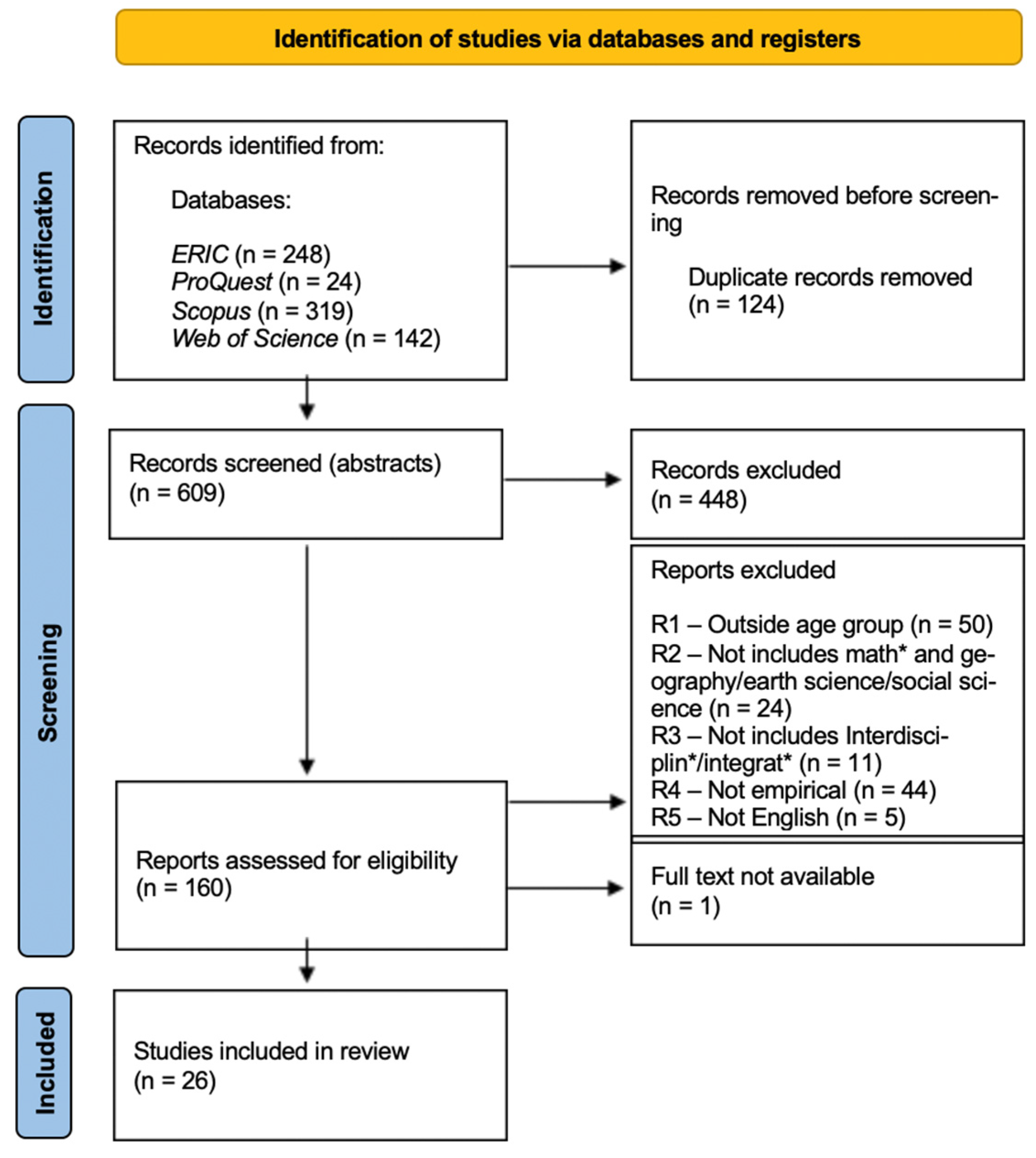
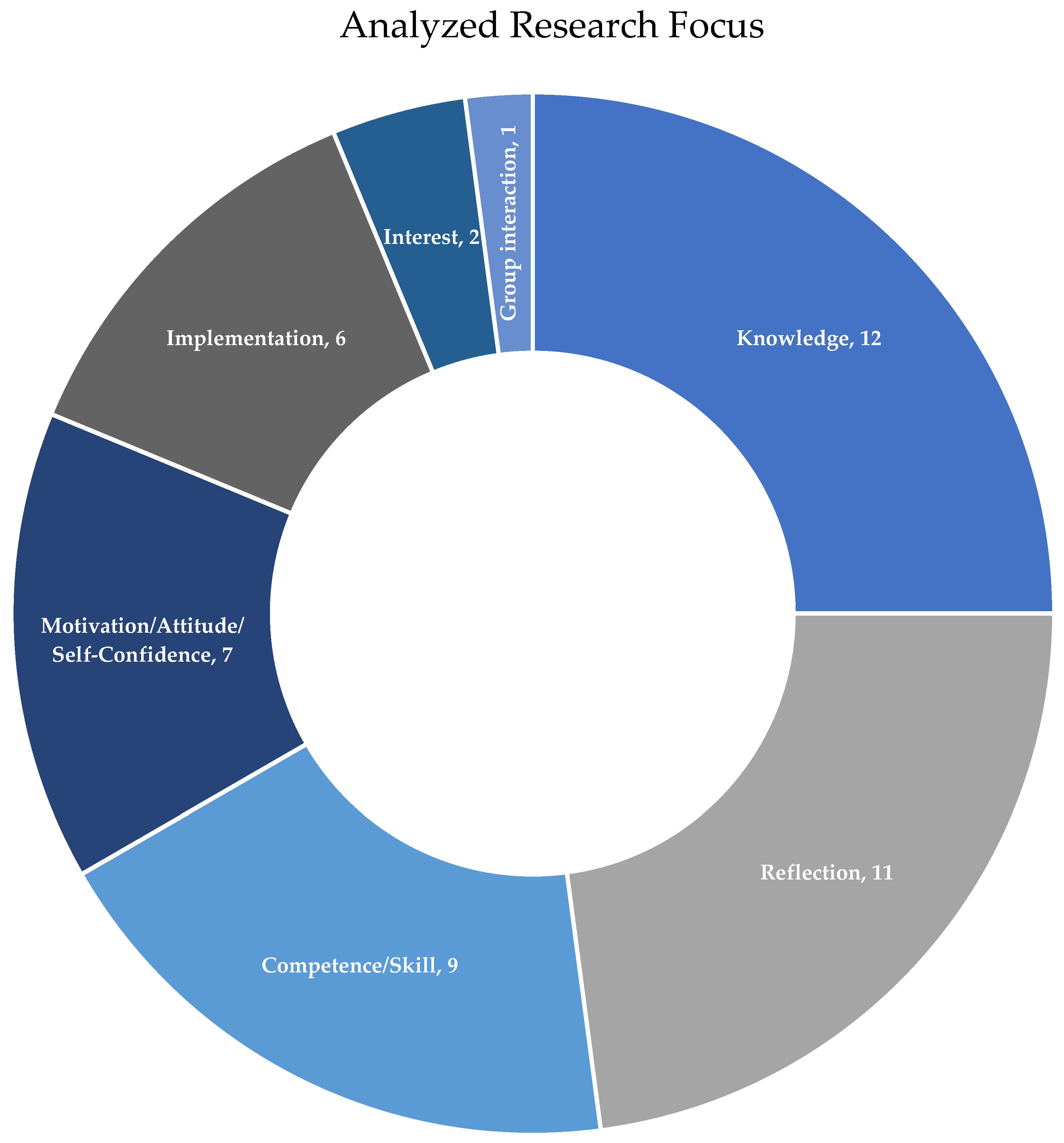
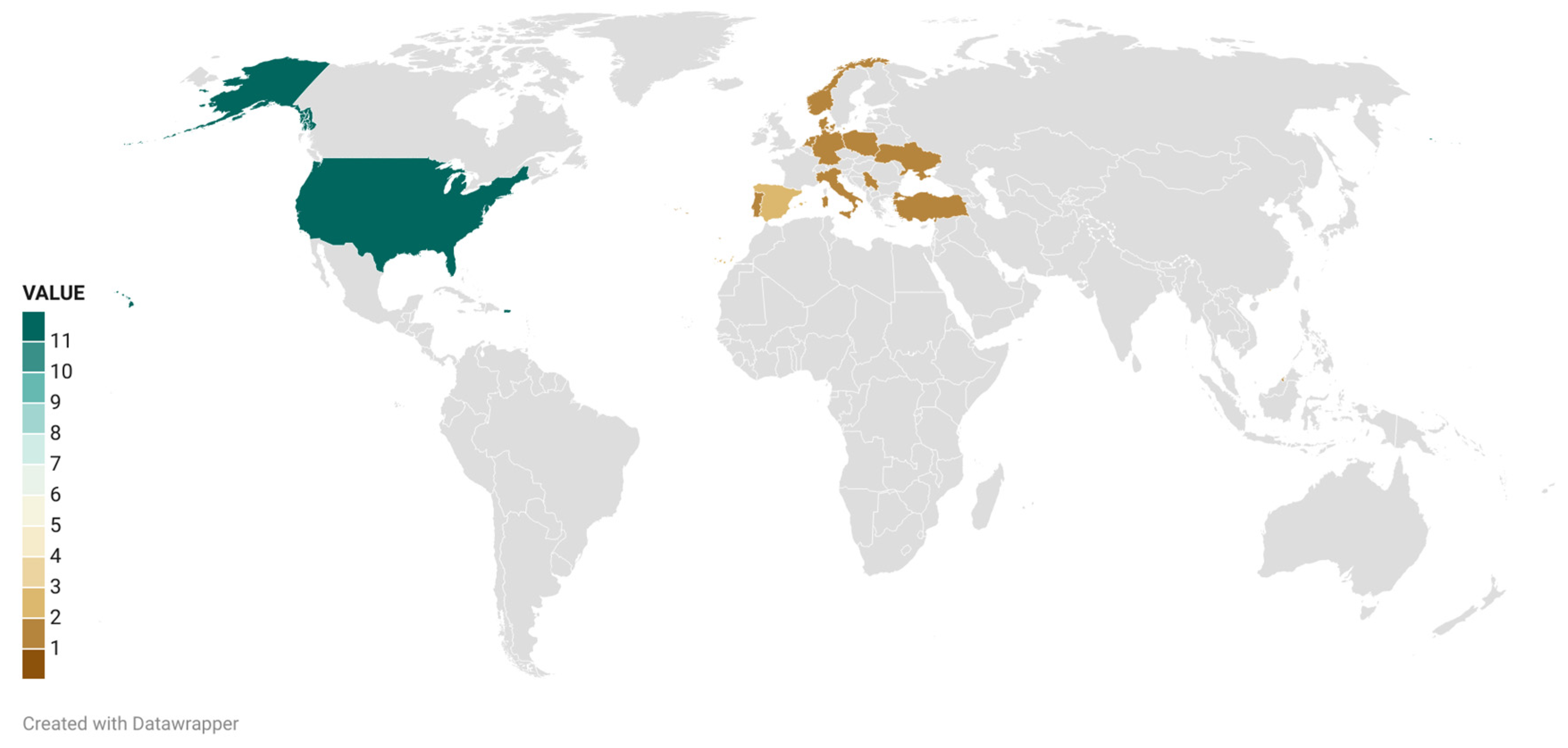
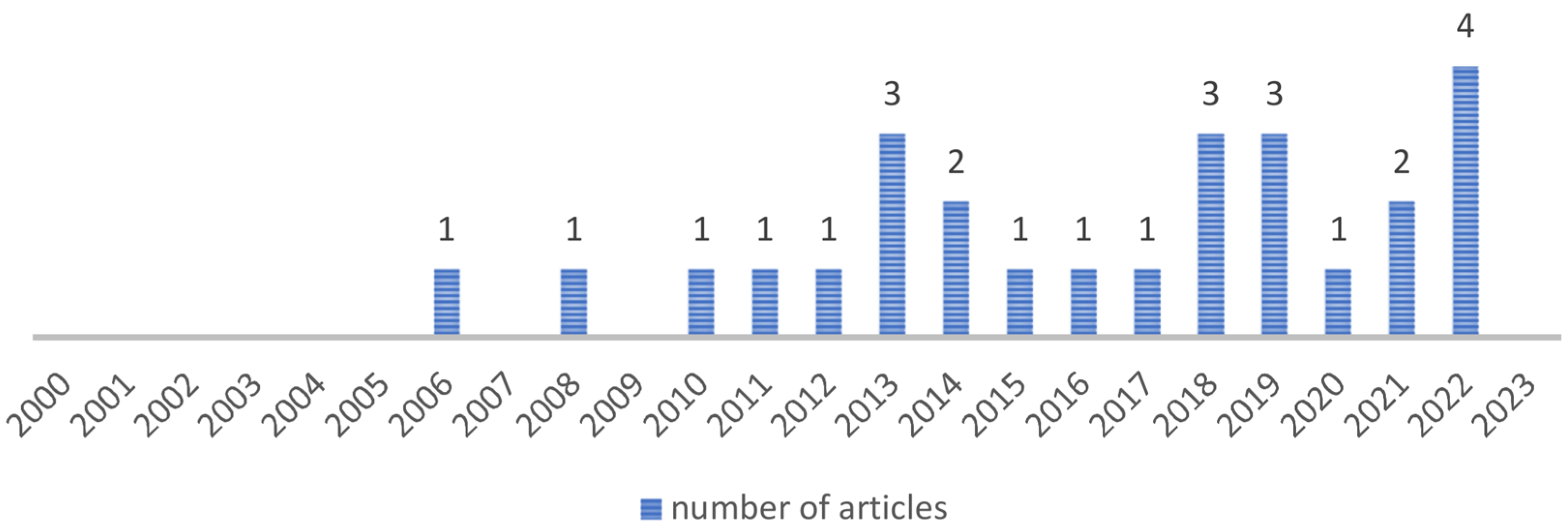
| Forms | Description | Representation | Level of Integration |
|---|---|---|---|
| Disciplinary |
|  |  |
| Multidisciplinary |
| 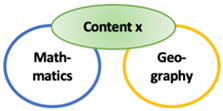 | |
| Interdisciplinary |
| 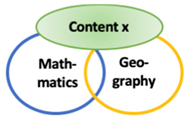 | |
| Transdisciplinary |
|  |
| Main Category (C) | Content | Source | Number (n = x) |
|---|---|---|---|
| C 1: Cartography | Robotics technologies and geoinformatics (GPS/GIS) | Adamchuk et al. [51] | 8 |
| Geographic Information Systems (GIS) and Global Positioning System (GPS) | Benimmas et al. [44] | ||
| Working with maps and coordinates | Cyvin, 2013 [49] | ||
| Topology in the immediate vicinity | Groessler et al. [50] | ||
| Drawing with consideration of the scale | Mahanin et al. [43] | ||
| Geographic Information Systems (GIS) | Mitchell et al. [46] | ||
| Mobile game with GPS in the field | Wijers et al. [56] | ||
| Geographic information systems (GIS) and information assurance (IA) | Xie & Reider (2013) [57] | ||
| C 2: Education for Sustainable Development (ESD) | Working on problem-based learning environments on the topic of ESD | Fernández-Morante et al. (2022) [58] | 9 |
| Declining bird population | Guzey et al. [59] | ||
| Water quality and environmental sensors | Hotaling & Stolkin [55] | ||
| Ecological crisis of Lake Nyos in Cameroon | Hrynevych et al. [21] | ||
| Food labeling | Lipan et al. [60] | ||
| Internet of Things | Moreira et al. [61] | ||
| Ecology with protection and improvement of the environment | Niklanovic et al. [54] | ||
| Climate change and sea level rise | Oldakowski & Johnson [7] | ||
| Impact of waste production on the climate | Stacchiotti et al. [24] | ||
| C 3: Astronomy and space travel | Investigation of samples in the field compared using the analogy of Mars exploration | Arino de la Rubia [53] | 4 |
| Working day of an astronaut | Kolodziejczky et al. [45] | ||
| Working day of a pilot | Ng & Chu [62] | ||
| Web-based spreadsheet with astronomy data sets | Schwortz & Burrows [22] | ||
| C 4: Scientific work | Scientific work | Reid & Roberts [52] | 1 |
Disclaimer/Publisher’s Note: The statements, opinions and data contained in all publications are solely those of the individual author(s) and contributor(s) and not of MDPI and/or the editor(s). MDPI and/or the editor(s) disclaim responsibility for any injury to people or property resulting from any ideas, methods, instructions or products referred to in the content. |
© 2025 by the authors. Licensee MDPI, Basel, Switzerland. This article is an open access article distributed under the terms and conditions of the Creative Commons Attribution (CC BY) license (https://creativecommons.org/licenses/by/4.0/).
Share and Cite
Kellinghusen, A.; Orschulik, A.; Vorhölter, K.; Sprenger, S. Integrated Teaching in Geography and Mathematics Education: A Systematic Review. Sustainability 2025, 17, 7276. https://doi.org/10.3390/su17167276
Kellinghusen A, Orschulik A, Vorhölter K, Sprenger S. Integrated Teaching in Geography and Mathematics Education: A Systematic Review. Sustainability. 2025; 17(16):7276. https://doi.org/10.3390/su17167276
Chicago/Turabian StyleKellinghusen, Anna, Anna Orschulik, Katrin Vorhölter, and Sandra Sprenger. 2025. "Integrated Teaching in Geography and Mathematics Education: A Systematic Review" Sustainability 17, no. 16: 7276. https://doi.org/10.3390/su17167276
APA StyleKellinghusen, A., Orschulik, A., Vorhölter, K., & Sprenger, S. (2025). Integrated Teaching in Geography and Mathematics Education: A Systematic Review. Sustainability, 17(16), 7276. https://doi.org/10.3390/su17167276






